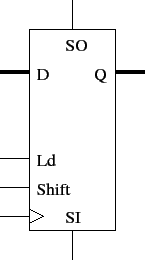
SO = SI four clocks later.
Using 2-1 muxes, how would you modify this to incorporate a shift control signal?

D and Q are buses.
Tom Kelliher, CS 240
Apr. 23, 2012
Read 7-6, 7-11.
Registers
Counters

SO = SI four clocks later.
Using 2-1 muxes, how would you modify this to incorporate a shift control signal?

D and Q are buses.
If A and B are ![]() bits, the output can be how many bits?
bits, the output can be how many bits?
Use this to design a sequential circuit which takes A as serial input and outputs 3A.
Parallel load, shift left or right, hold.
-- Parallel load shift register. Shift left or right.
-- Mode bits:
-- 00: hold
-- 01: load
-- 10: shift left (toward msb)
-- 11: shift right (toward lsb)
--
-- msi: most significant shift in.
-- lsi: least significant shift in.
library ieee;
use ieee.std_logic_1164.all;
entity shift_reg is
port (
d : in std_logic_vector (31 downto 0);
mode : in std_logic_vector (1 downto 0);
clk, reset_n : in std_logic;
msi, lsi : in std_logic;
q : out std_logic_vector (31 downto 0));
end shift_reg;
architecture behavioral of shift_reg is
signal state : std_logic_vector (31 downto 0);
begin -- behavioral
q <= state; -- Update output.
state_register: process (clk, reset_n)
begin -- process state_register
if reset_n = '0' then -- asynchronous reset (active low)
state <= X"00000000";
elsif clk'event and clk = '1' then -- rising clock edge
if mode = "00" then -- Hold.
state <= state;
elsif mode = "01" then -- Load.
state <= d;
elsif mode = "10" then -- Shift left.
state <= state (30 downto 0) & lsi;
else -- Shift right.
state <= msi & state (31 downto 1);
end if;
end if;
end process state_register;
end behavioral;